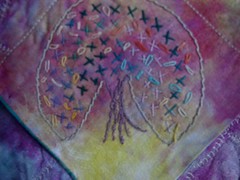I stand at my window on a cool, damp January day, beginning the important first step of gardening: planning. At the moment, the garden beds harbor perennial plants storing up moisture and energy for the next year's growth. The lawn is bright green with a weedy annual grass that will die with the first hint of temperatures over 80 degrees. Weeds are dominating both the lawn and garden beds.
Later this winter, I will undertake a major yard renovation, removing the lawn and some of the shrubs in my very small yard and replacing them with drought-tolerant California native plantings. Paths will lead back to a spot to sit and read under the shade of our sweet gum trees, and beyond to the garden beds of vegetables and fruit trees.
Even with most of the work ahead of me, I'm planning how all this will look now, because late winter is the perfect time to carefully decide what will be growing in our gardens this year.
Even if you aren't facing major yard work, the catalogs arriving in the mail are a signal to think about this year's gardens. Without a plan, we will buy too many seeds, plant at the wrong times, and increase the chance of failure even before Mother Nature get her hands into our garden.
What Goes Into a Garden Plan?
- How much space you have to work with. For all of us this, is a finite number, and the major control on planting. Measure the space and try to map it out on graph paper.
- What you already have planted. Mark off the space for bulbs and bushes, drip irrigation, anything that's not moving/movable in your plan.
- When things happen. A bush that flowers in May (like lilac) needs to be visible then. However, if it then becomes simply a mass of green leaves, note to plant something exciting in front of or next to it, to provide interest during the rest of the summer.
- Your safe planting dates. When can you start planting cold-hardy varieties? When is your first/last frost date? Know your growing zones.
- Now start dreaming...
I see grasses blowing in my bay-influenced breeze, sturdy bushes providing shelter for the birds, and crunchy gravel paths. In the edible garden, blueberries will be added, kale will be repeated. Will there be a place for some cleome somewhere?
Others Planning Their Gardens:
Julee Dunekacke is starting her southern garden already by planting onions, mustard, garlic and radishes.
Lara DeHaven, a Southeast Texas gardener, doesn't follow the local trend of planting mid-February, preferring to hold her planting until March, thus avoiding the chance of a late freeze.
Stephanie Langford talked seeds: knowing days to maturity, characteristics and features, planting both early and late varieties to spread out the harvest, and sometimes planning yield of vegetables.
Joyful Stars has decided to experiment with hay bale gardening this year. I'll admit this is a technique I always wanted to try myself. I'll keep an eye on her progress through the summer.
Seed Savers Exchange talked edible landscaping.
Eat. Drink. Better. wrote important tips for fighting cabin fever by planning the garden.
I also blog at: Weight for Deb and BlogHer on Wednesdays and Saturdays.






